
|
 The Glassware Gallery
The Glassware Gallery
Stopcocks
Introduction
Stopcocks regulate the flow of liquids or low pressure gases just like a kitchen water faucet. Stopcocks serve many functions in the laboratory and come in many different forms. Several of the most common types of stopcocks are discussed here.
Glass Stopcocks
These are the most common types in the laboratory. Some are ground glass with a solid ground glass plug, while others are smooth glass with Teflon plugs. The stopcock can have a straight or oblique bore and even a double oblique bore as shown below. Some stopcocks can even have a 3-way or 4-way bore:

For routine laboratory operations, ground glass stopcocks should be coated with silicone grease. Using your finger, rub the grease evenly around the glass plug and then insert it into the stopcock. Push in and turn the stopcock back and forth a little bit. You should not see any streaks and the joint will no longer look opaque. Make sure the bore in the plug lines up with bore in the sidearms. If not, then find another plug.
Glass plugs are usually held in place by a green metal clip (on the right in the drawing above). These clips fit into a slot on the protruding end of the plug and keep the plug from popping out of the stopcock. People sometimes find these clips rather confusing, but they are really quite easy to use. To install a clip, compress the prongs and slide the clip into the slot on the plug with the wider side of the clip facing away from the stopcock. The tension of the clip trying to spring apart holds the plug in place.
Simple Teflon stopcocks do not require any grease. However, it is important to assemble these in the correct order as shown in below on the right. First install the plug and then put on the Teflon washer, Viton O-ring and nut. Tighten the nut with your fingers, but not so much that the stopcock can not turn easily. Take care not to strip the threads on the plug. A common misconception is that the O-ring provides a leak-proof seal. This is actually accomplished by the Teflon washer -- the O-ring actually controls how hard it is to turn the stopcock.

Glass High Vacuum Stopcocks
High vacuum applications demand stopcocks that are high quality. There are several different kinds of glass high vacuum stopcocks, some of which are shown here.
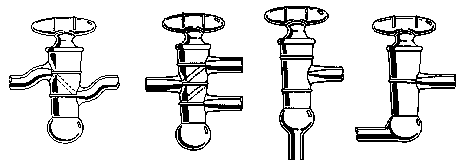
Important: Glass high vacuum stopcocks are matched to their plugs. You can not interchange the plug from one high vacuum stopcock with another -- the match may be close but it will not be perfect. To prevent accidental mix-ups, both the plug and the stopcock have a number etched or painted on them. If you break the plug, you should consult with your glassblower on what to do.
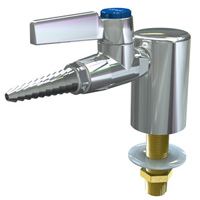
Safety Emporium carries faucets and valves in addition to stopcocks.
All of the stopcocks shown have a glass plug that is hollow and open at the end. The two on the left have an additional bore hole oriented perpendicular to the bore that is illustrated (but not intersecting it). When these stopcocks are rotated 90 degrees this hole will line up with one of the sidearm bores, permitting the back of the stopcock to be evacuated. This vacuum keeps the plug in place. The two stopcocks on the right are "flow through" so you don't need to worry about evacuating the back of them.
Teflon(tm) / PTFE High Vacuum Stopcocks
Teflon(tm) (polytetrafluoroethylene, PTFE) has the distinct advantages over glass high vacuum stopcocks of not being subject to streaking after moderate use and being much easier to clean. No grease = no streaking = no leaks = better vacuum. For liquid applications, it also means that you won't contaminate your reaction mixture with grease. Best of all, PTFE is inert even under harsh reaction conditions.
Teflon(tm) stopcocks are much easier to open a small amount than those shown above because they turn on and off like a faucet. Some have specialized tips and bores to allow very fine flow control ("needle valves"). Teflon stopcocks come in a variety of configurations as shown below:
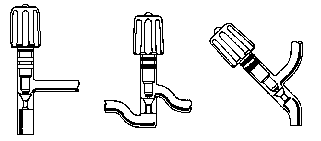
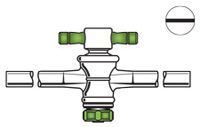
Safety Emporium carries replacement valves and stopcocks.
The Teflon(tm) plugs typically have 2 or 3 Teflon(tm) or Viton(tm) O-rings. Two of these are along the shaft of the plug and the third one is at the tip. When the tip seats against the glass barrel then the stopcock is closed. To close the stopcock, turn the Teflon(tm) plug clockwise and look for the O-ring to compress (if there is no O-ring at the tip, look for a telltale white band that indicates the Teflon tip has contacted the glass). DO NOT OVERTIGHTEN THESE STOPCOCKS. You just need to make contact with the glass. Over-tightening will either strip the Teflon(tm) threads or shatter the glass barrel of the stopcock.
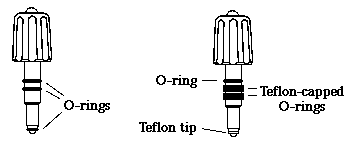
Teflon(tm) does not need to be greased, but the O-rings on the shaft of the plug should be treated with an extremely thin coating of grease. A good way to do this is to simply rub your nose with your thumb and forefinger and then rub the O-ring (honest. No kidding). Alternatively, Apiezon M grease is a good choice. This will make the shaft slide into the barrel quite easily and will make turning the stopcock even easier.
NEVER FORCE A TEFLON(tm) STOPCOCK If the shaft won't catch the threads and start turning it is either damaged, misaligned, the wrong size or the O-rings were not greased. Forcing the stopcock will either strip the Teflon(tm) threads or shatter the glass barrel of the stopcock.